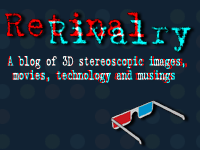Back in January of 2012, I saw a demonstration at the Consumer Electronics Show of an autostereoscopic android tablet, and I was impressed by what I saw. There had already been several glasses-free tablets on the market, but they suffered from color-fringing issues that I found to be unacceptable. This tablet, however, appeared to have a much higher quality display. It was called the WikiPad, and the American company exhibiting it explained that they would hopefully have it in stores in several months - but that they were waiting for their Chinese manufacturer to go into production on the final model. I began to anticipate the day when this prototype would be released as an actual product.
Now, I had already been disappointed the year before, when a Korean company announced a passive polarized tablet, but failed to deliver. So it came as no surprise when WikiPad missed their release date, and then announced that they had dropped their 3-D functionality in the final version. The story, as I heard it, was that the Chinese manufacturer, a company called Gadmei, was experiencing delays and quality issues.
I had heard of Gadmei - they had already made several 3-D tablets and digital photo frames which, unfortunately, had all suffered from the color-fringing issue. But if they could work out the production problems with this new tablet, it could be a winner. In November of 2012, the internet message groups started buzzing with the news that Gadmei was preparing to finally release the tablet - now called the E8-3D - and that it would be available in China by the end of the year. In December, reports started coming in of the first batch of tablets being available through a wholesale importer. I was intrigued, but the initial reviews reported some quality control issues with the barrier-screen, and some difficulties navigating the Chinese language menus.
January 2013 brought another CES, and this time Gadmei was actually there demonstrating the tablet themselves. Their display model looked great, so once again I got excited about it. I was aware that Gadmei’s products were sometimes re-branded and released in the USA by multiple distributors, so I decided wait to buy one until it was available locally.
I didn’t have to wait too long. As expected, this past spring several companies announced that they were releasing glasses-free 3-D tablets. A little research showed that while they were each branded differently, the Neo3DO, 3Dinlife, Aiptek, Nav3D, and 3D Window tablets were all the same Gadmei E8-3D. The only differences, as far as I could tell, were the pre-installed software, and the price (the lowest priced was over $100 cheaper than the most expensive one).
I ended up buying the “3D Window” from the 3DTV Corp. eBay store, and had the tablet in hand two days later (it shipped from Henderson, NV). It came with an AC battery charger, USB cable, USB adapter, and an HDMI video cable. I also picked up a tablet cover at my local Best Buy - the 7” Rocketfish brand cover fit perfectly. The tablet came with pre-installed 3DPlayer software from Viren, which allows viewing of streaming video from the internet, including Youtube 3-D, and playback of both 3-D video and still photos from the internal micro-SD card and from USB connected devices. I also purchased and installed Masuji Suto’s android app, 3DSteroid Pro, which brings the photo alignment tools of his Stereo Photo Maker program to the android platform.
After two months of using the tablet, I am quite pleased with it. It’s a very capable android tablet, 3-D aside, and 3-D videos and photos look great on it’s 7” HD screen. Also, by using the USB adapter cable, I found that I am able to connect a FujiFilm W3 or a Panasonic 3D1, and instantly look at photos directly from the camera. This is especially great for the Panasonic, which doesn’t have a 3-D display of it’s own! The one caveat I have for potential owners - dropping the tablet can knock the barrier out of alignment (learned the hard way).
A number of other LA 3-D Club members have also purchased this tablet. A Yahoo discussion group has been started, and a “3-D tablet Forum” has already held it’s first group meeting to discuss tips and tricks, compare notes, and help each other to get the most out of their devices. I would encourage anyone who gets one of these tablets to share their experiences with the club.
